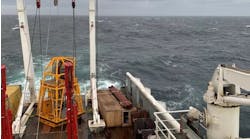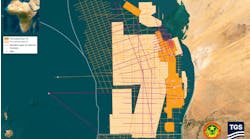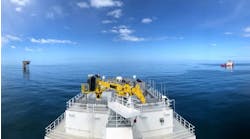New frontiers often a state of mind
Frontiers are often a state of mind - even an older, well-explored basin is a frontier to a fresh set of geo-eyes. There are rock systems to learn, faulting patterns to define, velocity changes to understand, environments of deposition to trace, genetic units to mark, porosity trends and fluid histories to discern, among many other elements of exploration to locate oil and gas. There is so much work to be done, it is almost inconceivable that companies would be reducing their scientific brain-power.
For the geoscience experts released, a new frontier has opened. They are now free to offer their talents to the broad market, rather than confine themselves to a single company. It is forbidding territory, after the comfortable envelope of a corporate sponsor (even as thin-shelled as they have been since 1986). It is an economic frontier and should be approached with the vigor applied to a new license or concession.
Every geoscientist has unique understandings and capabilities that have value to the market. The struggle is to connect those skills to the universe of companies that need those unique understandings. Companies need geoscience talent. Outsourcing can be rewarding for those who are willing to spread their wings and fly in the turbulent economic winds.
Going elsewhere often rewarding
Many "newly freed" professionals often find their highest value in a foreign land, regardless of their current home. Many European and Asian practicioners are coming to the United States, while many US professionals are seeking opportunity in Africa and Asia. This trend and the adjustments needed were explored in the International Exploration Symposium 2000 hosted by the Houston Geological Society of Houston, Texas. Professionals need to learn about their new territory. Leases are available for small players, if a few simple principles are followed:
- Respect the new culture. It is their home and you are there to help them develop their resources.
- Respect their knowledge. You may bring special skills but they control the data and access.
- Learn about cultural differences and similarities. Avoid cultural conflicts and business-style issues in favor of win-win proposals.
- Get help from in-country experts. No matter how good your skills are, there are nuances that will be missed.
- Ensure that neutral third-party arbitration is part of your legal framework. It keeps the discussions focused on the economic issues and limits the effect of personalities.
EXPLORATION
New deepwater frontier
Fairway Basin, northeast of Lord Howe Island (which is northwest of Sydney, Australia), was found to hold significant numbers of very large sedimentary domes. The Australian Geological Survey Organization (AGSO) located the structures as part of the AUSTREA-1 mapping survey. The structures lie in water depths of 2,000-3,000 meters.
Multi-component survey
Petroleum Geo-Services (PGS) was awarded a contract to gather a seafloor multi-component survey for Philips Petroleum. "This contract will utilize breakthrough technology now being recognized by the industry," commented Bjarte Bruheim, PGS President and CEO. The survey will be gathered over PL 19-3 field in China's Bohai Bay and will begin this spring. Phillips recently announced the field as a major discovery with the northern portion estimated to hold 400 million bbl of recoverable oil. p PGS will gather a multi-component survey for Phillips Petroleum in China's Bohai Bay.
Nova Scotia survey
Veritas DGC will begin Phase II of its non-exclusive 3D survey offshore Nova Scotia using the Veritas Viking. The survey will cover 2,200 sq km over Scotian Shelf blocks NS98-2 to NS98-10, NS98-12, and NS98-13. Phase I of the full survey was completed last season. Coverage of both phases will total over 5,000 sq km when completed.
Nigerian exploration
Acker Geophysical will shoot a 550 sq km 3D survey for Tuskar Resources. The survey will be conducted over OML 110 to define six prospects located by an earlier 2D survey. Tuskar has drilled two deepwater wells on the block.
TECHNOLOGY
VSP advance
CGG has run its first dual-receiver vertical seismic profiling (VSP) in a horizontal development well in the German sector of the North Sea. High-quality three-component data with a useful frequency content of more than a 100 Hz was recorded along 1,000 meters of the horizontal section. The PipeSeistrademark technique involves pumping wireline-conveyed, 3-component receivers inside drill pipe to the bottom of the well and acquiring VSP data on the way out.
Log manipulation
Schlumberger Oilfield Services has developed of a suite of PC-based freeware utilities called Log Data Toolboxtrademark that provides maximum flexibility for wireline data, logging-while-drilling data, and graphics. The seven- application suite greatly simplifies manipulation of log data and graphics. "With the growing volume of electronically delivered data, applications were needed to facilitate immediate customer interaction. The Log Data Toolbox utilities were developed to allow clients to view and manipulate data as it is received. This flexibility will assist in ongoing wellsite activities and simplify next-step decisions." stated Stuart Murchie, Vice President of Schlumberger Data & Consulting Services.
Log data files can be viewed, filtered, and converted before integration into client interpretation software or data management systems. Data files can be output as DLIS, LIS, LAS, or ASCII formats. An enhanced version of PDSViewtrademark software allows PDS graphics files to be annotated, viewed, printed, and converted to GIF and CGM formats for use in other applications. The utilities are available on the company's web site or on CD-ROM.
Wide screen
Veritas Exploration Services, a Veritas DGC Inc. company, successfully installed a 18 ft by 7 ft viewing screen, for its new state of the art Visualization Center at its downtown Calgary headquarters The acrylic screen was lifted 27 stories and inserted through removed window panels of the office tower. The system will use new visualization technology and interpretation software, and power advanced hardware and customized software systems specifically designed to handle massive volumes of 3D seismic data. Teams of explorationists using the center will have access to advanced visualization analysis capabilities for viewing and interpreting multi-disciplinary exploration data in fundamentally new ways, for better interpretation of data in less time, with higher confidence in the result.


